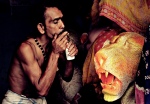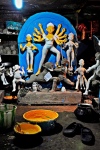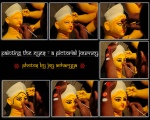Kumortuli (also spelt Kumartuli, or archaic spelling Coomartolly) is a traditional potters’ quarters in northern Kolkata (previously known as Calcutta), the capital of the state of West Bengal in India. Close to BagBaazar ghat, this small locality with narrow and dark lanes is the home and workshop of the finest clay-artisans in India. One needs to be there to believe the existence of this place. This is from the fact that, a regular studio extremely small (typically between 10-15 feet wide, 20-25 feet long and 10 feet high) houses a minimum of 7-8 full sized Durga idols beside other small idols of gods and goddesses. Hard to believe though, but this crampy place is the nerve center of the clay idol-making industry in Kolkata and also India. Amazing is the skill of these artists, who can draw a flawless eye on the face of the idol with a swift single stroke of a brush, working under a dimly lit bulb. They don’t have any space to look at their artwork from a distance yet they are magically perfect in proportion. Every part of the idol, be it the muscles of the demon, teeth and claws of the lion or ornaments of the gods and goddesses, all are done with perfect realism. Once only popular for their works within the country, these peoples have crossed the boundaries of India and are now in much demand throughout the world. By virtue of their extraordinary skills, they have made this art a profitable form of business also.
The history of Kumortuli can be traced back to the middle of the 17th Century. Potters from Krishnanagar (a place in South Bengal, famous for its potters) came to Gobindapore, a prosperous village on the banks of the river Bhagirathi (now the River Hooghly), to find a living by making earthen ware pots, clay toys and cooking utensils for household use. When the land at Gobindapore was required by the British East India Company for construction of Fort William, the potters migrated further up the river to Sutanuti. In their new destination, they colonized a vast area and named it Kumortuli, the term “Kumor” meaning a potter and “tuli” a locality. The Bengal Consultations, a journal of 1707 AD, gives an account of the presence of Kumors who occupied 75 acres of land in Sutanuti, which is a sizeable part of present day north Calcutta. The Asiatic Society of Calcutta estimates that the first formal “puja” of Durga was held around 1606 A.D. at the present BagBaazar area in Kolkata by a zamindar Pran Krishna Halder. Four years later, the Kumortuli’s “Kumors” started making the idols of “Maa (mother goddess) Durga” in clay for the newly rich zamindars Laxmikanta Roy Mazumder, who is the first patron of Kolkata’s potter’s town and initiator of the “puja” of Durga in clay idols.
Making an idol involves several steps. First a skeleton of the figure is made using bamboo which stands on a wooden base. This figure is given a rough shape with straws tied with jute strands. A thick base coat of black clay mixed with little straw pieces is applied on the straw dummy figure. After this dries up completely, progressive smoother layers (made of a mixture of sand-clay and jute fiber) are added and cracks are filled up. The heads and fingers are usually made with moulds and once they are fixed to the body the delicate and intricate detailing works are done manually using only brushes and bare hands. The joints of limbs are wrapped in pieces of cloth previously soaked in clay solution. The figure is white-washed two or three times over with chalk solution. Once this is over, the painting starts. Nowadays many artists use spray paint for the base colours. Brush is used for detailing. Then hair, mane, fur etc made from jute strands are added, and the gods and goddesses are dressed up with clothes and the ornaments.
Most of them shape the icons in the traditional mould, following the time-honoured traditions in an age of modernity. They are made in two distinct styles, either in the Bangla or Do-Bhashi mould. The shapes and contours of the Bangla mould or visage is triangular, with a square chin, the hooked nose of a parrot and bamboo-leaf eyes and brows that extend from the bridge of the nose to the hairline. The Do-Bhasi mould, is comparatively softer. The complexion, too, is idealized like molten gold, more often yellow as the sun at start of dawn.
The final touch, which is considered as the most delicate and intricate step, is called “Chokkhu-Daan” or “Painting of the third eye” and is usually done by the most senior, experienced and skillful artist of the family. It is said that before drawing the eye, some artist perform rituals and meditate for long hours and then in a state of trance completes the third eye with a swift single stroke of brush.
Though these artists work throughout the year for their living, the major work flow starts just 2-3 months before the Durga Puja. All the major and large idols are made for this five-days-long festival, which is considered as the biggest festival among the Bengalis. However, this total process of clay idol making ends up with the immersion of these great works of art in the waters of river Ganges on the fifth and last day of the festival. In spite of all the problems faced by them and limited scope for display of their works, these people with their great skill and form of art have undoubtedly become an integral part of Bengal’s art history.
For complete collection of images : Click Here.
Acknowledgements:
- Artisans of Kumortuli (They allowed me to take photo of their works)
- Sova Bazar Kasari Bari (Photo of the completed idol is from their puja pandal taken on the year 2009)
References:
- http://en.wikipedia.org/wiki/Kumortuli
- http://www.indiaprofile.com/art-crafts/claymodelling.htm
- Home Chowdhury, Amlan. “Kumartuli, Potters Town”. littleindia.com. Retrieved 2007-07-15.
- Kolikata Darpan – Radha Raman Mitra
- Sotik Hutom Pnechar Noksha









